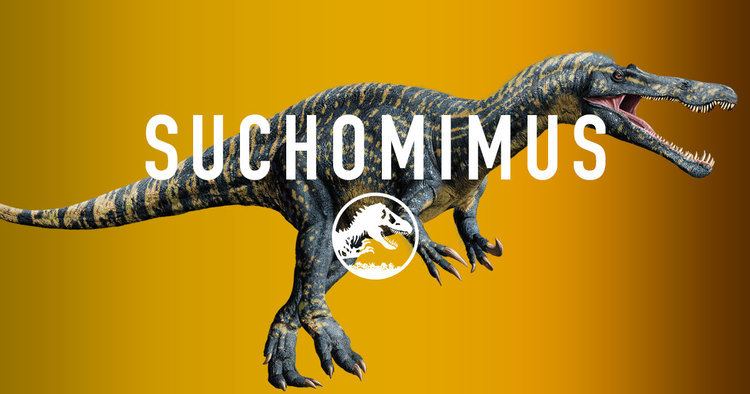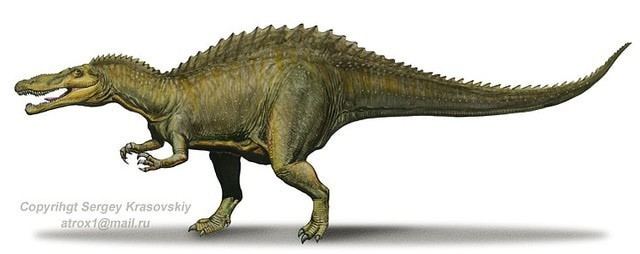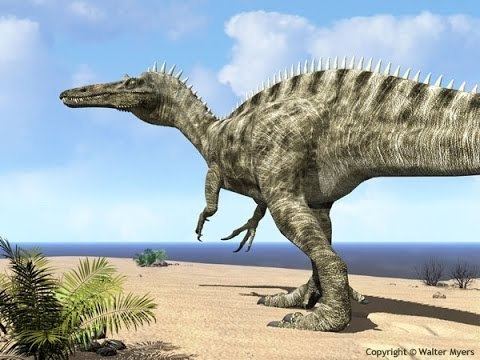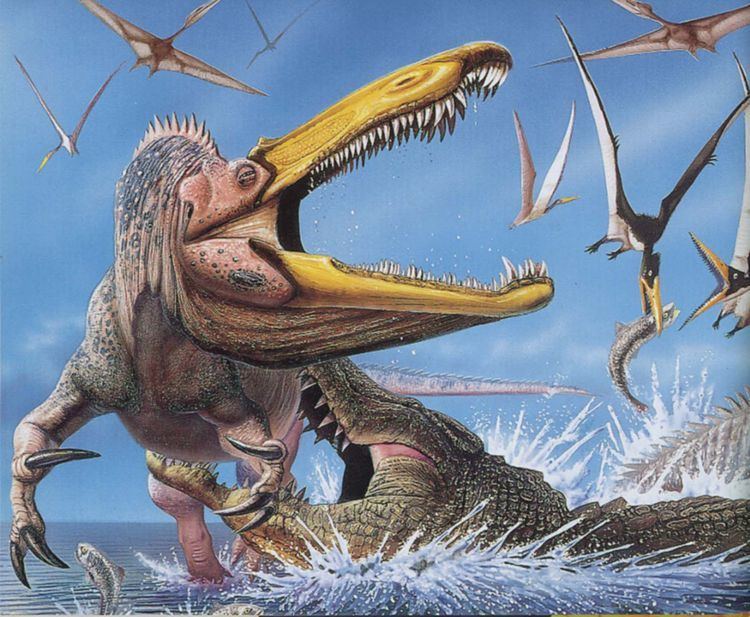Scientific name Suchomimus Rank Genus | Higher classification Baryonychinae | |
 | ||
Similar Dinosaur, Baryonyx, Spinosaurus, Irritator, Spinosauridae | ||
Dino battles suchomimus vs tyrannosaurus rex trailer
Suchomimus ("crocodile mimic") is a genus of large spinosaurid dinosaur with a crocodile-like skull that lived between 121–113 million years ago, during the late Aptian stage of the Cretaceous period in Niger, Africa. The only species named in the genus is Suchomimus tenerensis.
Contents
- Dino battles suchomimus vs tyrannosaurus rex trailer
- Description
- Discovery and naming
- Palaeobiology
- Classification
- References

Description

The length of the type specimen of Suchomimus, a subadult, was initially estimated at 10.3–11 m (34–36 ft). Its weight was estimated at between 2.7 and 5.2 tonnes (2.7 and 5.1 long tons; 3.0 and 5.7 short tons). In 2010, Gregory S. Paul gave lower estimations of 9.5 metres and 2.5 tonnes.

The describers established some unique derived traits or autapomorphies of Suchomimus. The praemaxilla has an upward branch excluding the maxilla from the bony nostril. The neural spines on the rear dorsal, sacral and front tail vertebrae are expanded in side view. The upper corners of the humerus are robust. The humerus has a boss above the condyle that contacts the radius, that is hook-shaped.

Unlike most giant theropods, Suchomimus had a very long, low snout and narrow jaws, formed by a forward expansion of the premaxilla and the anterior ramus of the maxilla. The jaws have about 122 conical teeth, pointed but not very sharp and curving slightly backward, with fine serrations. The tip of the snout was enlarged sideways and carried a "rosette" of longer teeth, seven per side in the skull and about the same number in the corresponding part of the lower jaw. Further back, there are at least twenty-two teeth per upper jaw side in the maxilla, while the entire lower jaw side carries thirty-two teeth in the dentary bone. The upper jaw shows a prominent kink just behind the rosette, protruding to below; this convexly curved part of the maxilla has the longest teeth of the entire skull. The skull is reminiscent of that of crocodilians that eat mainly fish. The internal bone shelves of the maxillae meet each other over a long distance, forming a closed front palate rigidifying the snout. The nostrils are long, narrow and horizontally positioned; the same is true of the larger antorbital fenestra. The rear of the skull is poorly known but a short quadrate, separated from the quadratojugal by a large foramen quadraticum, shows it must have been low. The lower jaws are very elongated and narrow, forming a rigid structure as their dentaries touch each other at the midline, reinforcing the mandible against torsional forces.
The neck is relatively short but well-muscled as shown by strong epipophyses. There are about sixteen back vertebrae. Suchomimus had neural spines, blade-shaped upward extensions on the vertebrae, which are elongated at the rear back. Those of the five sacral vertebrae are the longest. To behind, the elongation continues until the middle tail. The spines may have held up some kind of low crest or sail of skin that was highest over its hips, lower and extending further to the back than that of Spinosaurus.
The furcula is V-shaped and indicates a high and narrow trunk. The humerus is very strongly built, only equalled in size among Theropoda by that of Megalosaurus and Torvosaurus. Accordingly, the ulna of the lower arm is well-developed with an enormous olecranon, upper process, that is set-off from the shaft, an exceptional trait shared with Baryonyx. The heavy arm musculature powered sizeable hand claws, that of the thumb being the largest with a length of nineteenth centimetres.
In the pelvis, the ilium is high. The pubic bone has a front surface that is wider than the side surface. The thighbone is straight and robust, 1075 millimetres long in the holotype. Its lesser trochanter is markedly plate-like.
Discovery and naming
In 1997, palaeontologist Paul Sereno and his team at Gadoufaoua discovered fossils that represented about two-thirds of the skeletal elements of a huge meat-eater in Niger. The very first find, a giant thumb claw, was made on 4 December 1997 by David Varricchio. On 11 November 1998, Paul Sereno, Allison Beck, Didier Dutheil, Boubacar Gado, Hans Larsson, Gabrielle Lyon, Jonathan Marcot, Oliver Walter Mischa Rauhut, Rudyard Sadleir, Christian Sidor, David Varricchio, Gregory Wilson and Jeffrey Wilson named and described the type species Suchomimus tenerensis. The generic name Suchomimus ("crocodile mimic") is derived from the Greek σοῦχος, souchos, the Greek name for the Egyptian crocodile god Sobek, and μῖμος, mimos, "mimic", after the shape of the animal's head. The specific name tenerensis is after the Ténéré Desert where the animal was found.
The holotype, MNN GDF500, was found in the Tegama Beds of the Elrhaz Formation dating from the Aptian. It consists of a partial skeleton lacking the skull. It contains three neck ribs, parts of fourteen back vertebrae, ten dorsal ribs, belly ribs, pieces of three sacral vertebrae, parts of twelve tail vertebrae, chevron bones, a shoulder blade, a coracoid, a forelimb, a pelvis side, and parts of a hindlimb. The vertebral column was largely articulated, the remainder consisted of disarticulated bones. Parts of the skeleton had been exposed on the desert surface and had suffered erosion damage. Additionally, several specimens have been assigned as paratypes: MNHN GDF 501, a snout; MNHN GDF 502, a quadrate; MNHN GDF 503, a dentary; MNHN GDF 504, a dentary; MNHN GDF 505, a dentary; MNHN GDF 506: an axis; MNHN GDF 507, a rear neck vertebra; MNHN GDF 508, a rear back vertebra; MNHN GDF 510, a tail vertebra; and MNHN GDF 511, a tail vertebra. The fossils are part of the collection of the Musée National du Niger.
The initial description of Suchomimus was preliminary. In 2007, the furcula, found during a subsequent expedition in 2000, was described in detail.
Palaeobiology
The overall impression is of a massive and powerful creature that ate fish and presumably other sorts of meat — carrion — more than 113 million years ago, when what is today part of the Sahara was a lush, swampy habitat.
Classification
Suchomimus was placed in the Spinosauridae, a group of large predators with jaws adapted for hunting fish and with flatter skulls when compared to other similarly-sized theropods, like the Tyrannosauridae. Their teeth were adapted for grasping rather than slicing and the roof of the mouth was more solid, allowing the spinosaurids to resist twisting forces exerted by prey. The rest of the body was not particularly adapted to the water.
Within the Spinosauridae, Suchomimus was a member of the Baryonychinae. Apart from its possibly higher back crest, Suchomimus was very similar to the spinosaurid Baryonyx from the Barremian of England which also had strong forelimbs and a huge sickle-curved claw on its "thumb". And, as with Suchomimus, the claw of Baryonyx had been the first fossil part to be found in the field. The holotype of Suchomimus was considerably larger than that of Baryonyx, but the ages of the two individuals are not known. In 2002, several researchers concluded that Suchomimus was identical to Cristatusaurus lapparenti found in the same formation of Niger and, despite Cristatusaurus having been named somewhat earlier than Suchomimus, proposed them to represent a second species of Baryonyx called Baryonyx tenerensis.
Sereno et al. (1998) analyzed the distribution of forty-five traits to produce a cladogram that showed Suchomimus and Baryonyx to be distinct but closely related.
The following Phylogenetic tree shows a 2010 analysis of the Megalosauroidea.
